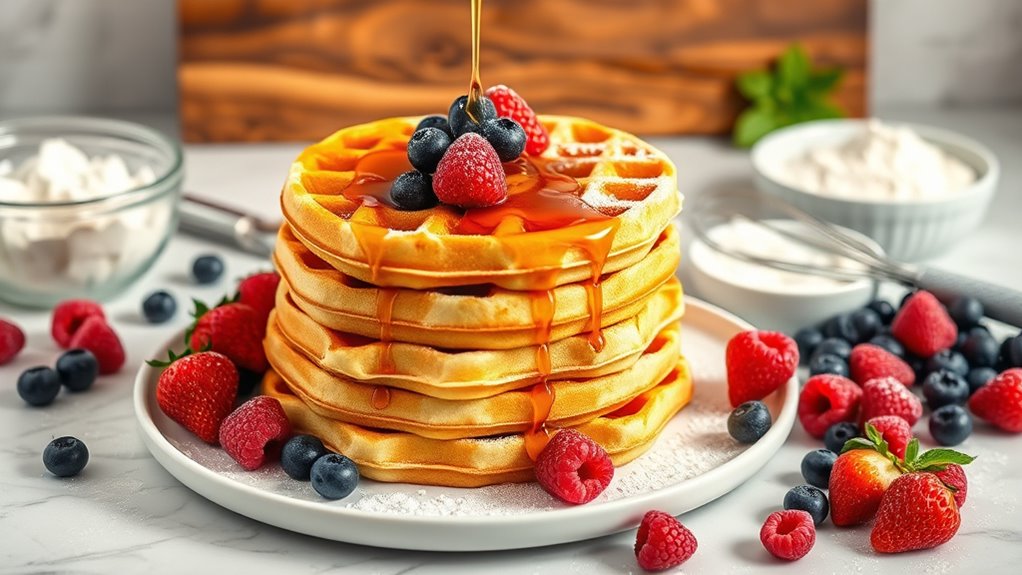To make perfect gluten-free waffles, start by measuring and mixing 1 cup rice flour, ½ cup tapioca starch, ¼ cup almond flour, and 1 tsp baking powder for balance and texture. Preheat and grease your waffle maker, then pour an even layer of batter. Cook 4-6 minutes until steam stops for crispness. Let waffles rest on a rack to avoid sogginess. Serve warm with fresh berries or nut butters. Keep following for detailed tips and nutritional benefits.
Ingredients and Quantity
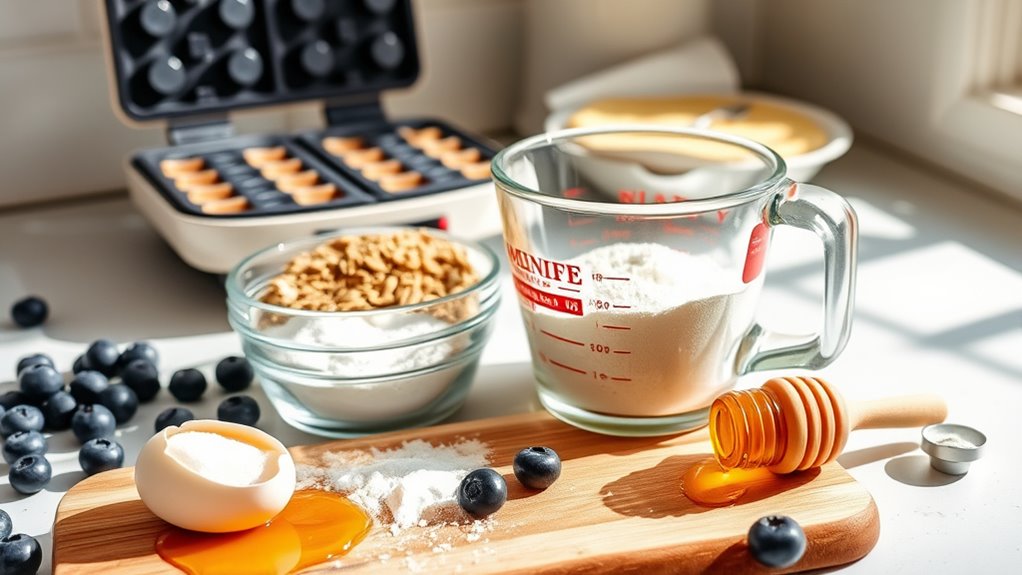
To make gluten free waffles that are both fluffy and flavorful, you’ll need a precise combination of ingredients. Selecting the right gluten alternatives is essential for texture and taste. Using a blend of rice flour, tapioca starch, and almond flour guarantees your waffles aren’t dense. Don’t forget leavening agents like baking powder for rise and eggs for structure. Finally, waffle toppings like fresh fruit or maple syrup complement the base and add freedom to customize.
| Ingredient | Quantity |
|---|---|
| Rice flour | 1 cup |
| Tapioca starch | 1/2 cup |
| Almond flour | 1/4 cup |
| Baking powder | 1 tsp |
This precise balance allows you to enjoy light, crisp waffles without gluten restrictions.
Preparations
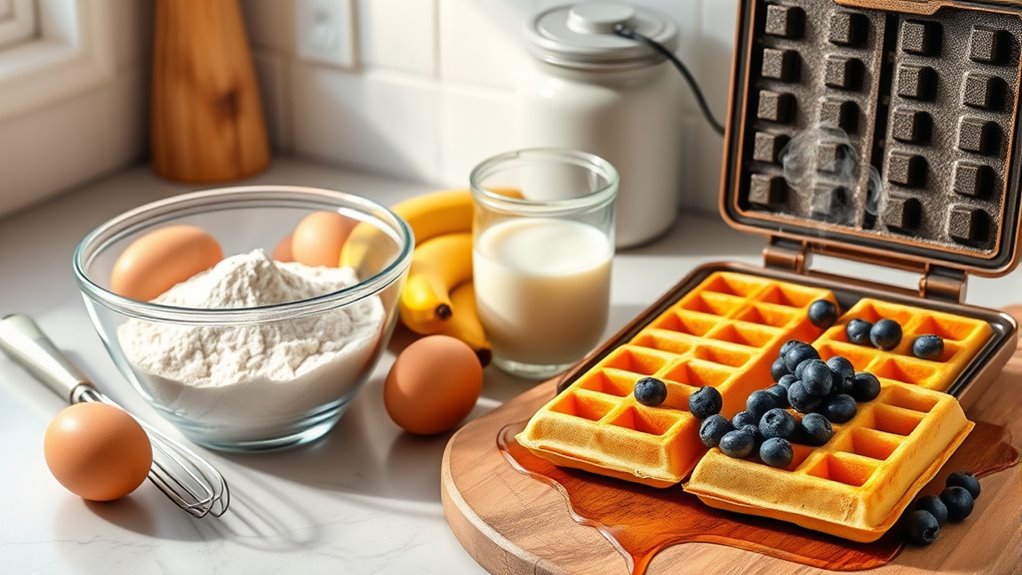
Since gluten free flours behave differently than traditional wheat flour, you’ll want to prepare your ingredients carefully to ascertain the best texture. Measure each component precisely, as gluten free batters rely heavily on accurate ratios to achieve the ideal batter consistency. When making ingredient substitutions—like swapping almond flour for rice flour—understand that moisture absorption varies, affecting texture and cooking time. It’s essential to combine dry ingredients thoroughly before mixing with wet ones to prevent clumps and guarantee even distribution. Let your batter rest for 5-10 minutes; this allows flours and starches to hydrate fully, improving structure. By attentively preparing your ingredients and respecting these nuances, you’ll enjoy waffles that are crispy outside, tender inside, and truly free from gluten restrictions.
Tools / Kitchenware Required
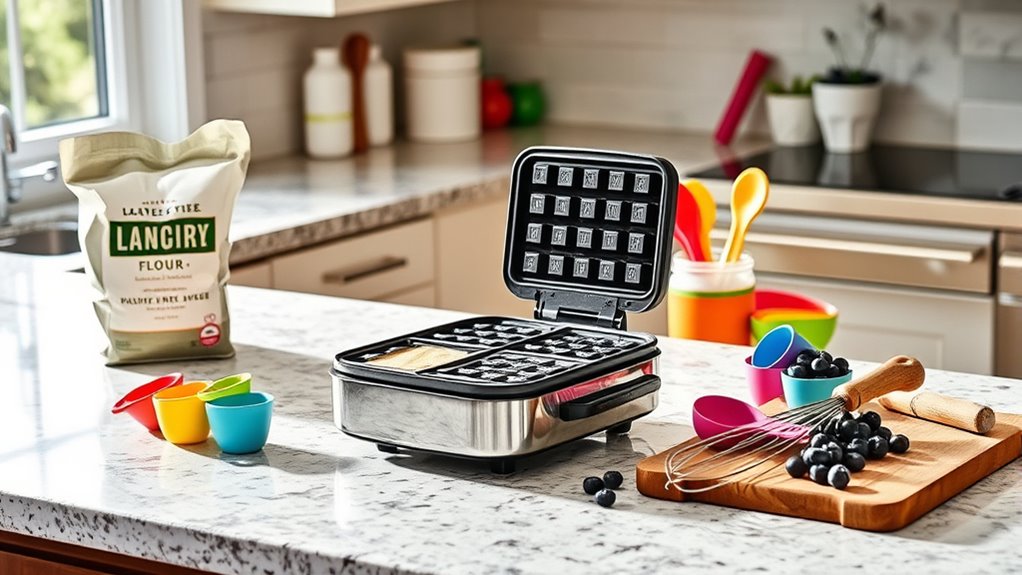
Three essential tools will make your gluten free waffle-making process smoother and more consistent. First, a reliable waffle maker guarantees even cooking and perfect texture. Second, sturdy mixing bowls help you combine ingredients thoroughly without contamination. Third, measuring cups and spoons assure accurate ingredient proportions, vital for gluten free baking success.
| Tool | Purpose |
|---|---|
| Waffle Maker | Even cooking, crisp waffles |
| Mixing Bowls | Thorough, contamination-free mixing |
| Measuring Cups | Accurate ingredient measurement |
| Whisk or Spoon | Proper batter consistency |
| Cooling Rack | Prevents sogginess post-cooking |
Using these tools grants you freedom from guesswork, improving consistency and reliability. Investing in quality kitchenware is key to mastering gluten free waffles confidently.
How to Cook
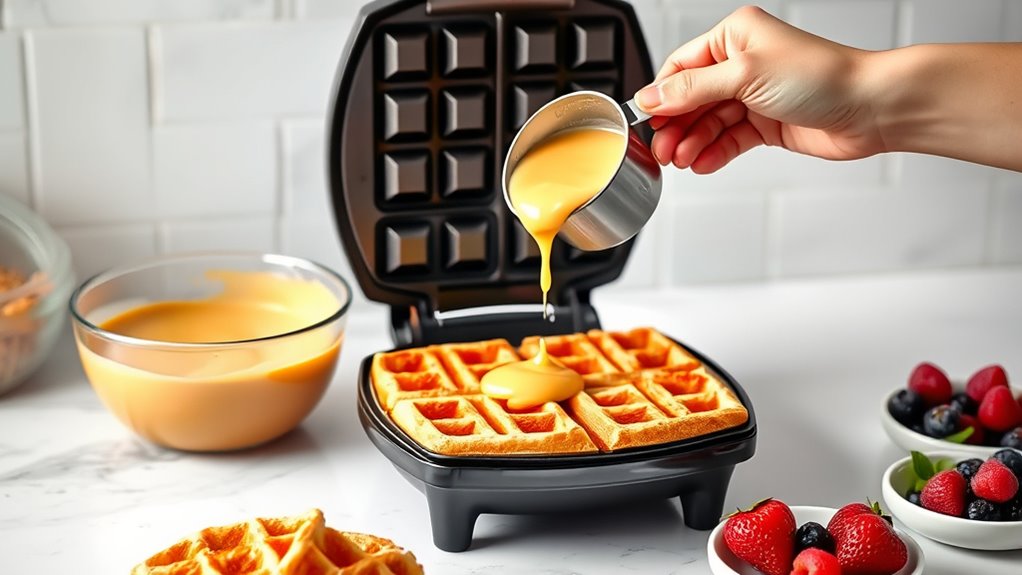
- Preheat your waffle iron thoroughly to guarantee even heat distribution.
- Lightly grease the surface to prevent sticking without altering texture.
- Pour batter evenly, avoiding overfilling which can cause uneven cooking.
- Cook until steam diminishes and waffles are golden brown, usually 4-6 minutes.
- Maintain crispness and proper structure by controlling timing and temperature precisely.
- Enjoy diverse gluten free waffle variations with consistent results.
How to Serve
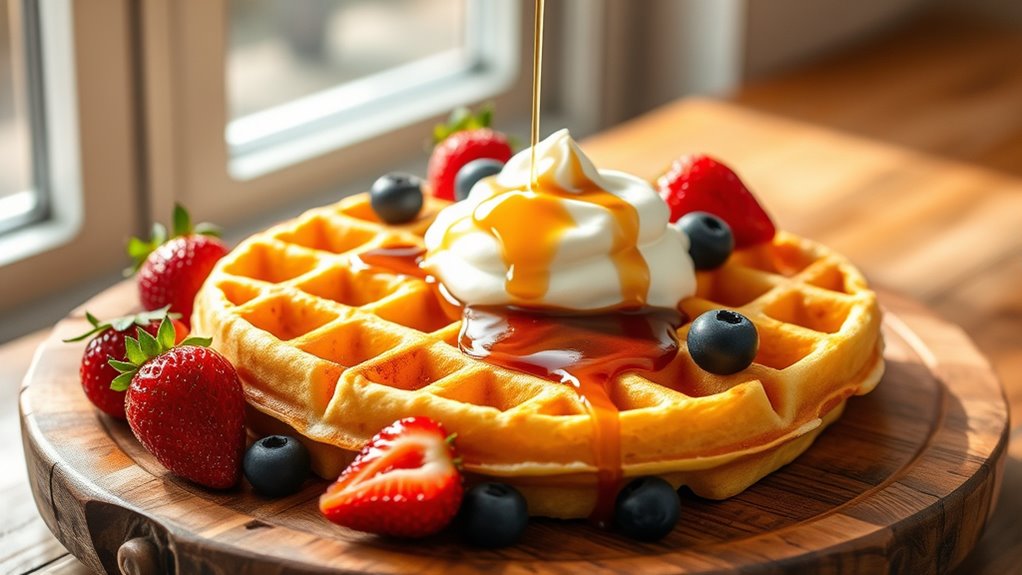
Anyone looking to serve gluten-free waffles should focus on balancing texture and flavor to enhance the eating experience. To keep waffles crisp, serve them immediately or keep warm on a rack instead of stacking, which traps steam. For topping suggestions, consider fresh berries, Greek yogurt, or nut butters to add moisture and nutrients without overpowering the waffle’s subtle taste. Syrups like pure maple or fruit compotes provide natural sweetness while maintaining a gluten-free profile. Regarding serving styles, you can present waffles as a hearty breakfast with eggs and avocado or as a dessert topped with whipped cream and dark chocolate shavings. By thoughtfully selecting toppings and serving methods, you guarantee each bite delivers satisfying texture and balanced flavor while honoring gluten-free needs.
Tips
To get the best results with gluten-free waffles, paying attention to specific preparation and cooking details can make a significant difference. You want your waffles crispy outside and tender inside, without any off-textures common in gluten-free baking.
Achieve perfectly crispy, tender gluten-free waffles by focusing on key preparation and cooking details.
Consider these tips:
- Use a blend of gluten-free flours for balanced texture.
- Let the batter rest 10–15 minutes to hydrate the flours fully.
- Preheat your waffle iron thoroughly to prevent sticking.
- Experiment with topping suggestions like fresh berries or nut butters and try flavor variations by adding cinnamon or vanilla extract to your batter.
Food Value and Benefit
Prepared gluten-free waffles made from a blend of almond, rice, and tapioca flours offer a nutritious alternative to traditional waffles. These waffles provide a well-rounded mix of macronutrients and micronutrients, contributing to overall health and energy.
Food Value:
- Rich in healthy fats and protein from almond flour
- Good source of carbohydrates from rice and tapioca flours
- Contains dietary fiber aiding digestion
- Provides essential vitamins such as Vitamin E (from almonds) and B vitamins (from rice flour)
- Supplies important minerals including magnesium, calcium, and iron
Benefits of Eating This Recipe:
- Supports sustained energy release due to balanced macronutrients
- Promotes digestive health through increased fiber content
- Helps maintain stable blood sugar levels, enhancing satiety
- Suitable for individuals with gluten intolerance or celiac disease, ensuring dietary freedom
- Contributes to heart health with the presence of healthy fats and antioxidants like Vitamin E
Frequently Asked Questions
Can I Make Gluten Free Waffles Ahead and Freeze Them?
Yes, you can make gluten free waffles ahead and freeze them. Use proper freezing techniques: let waffles cool completely, then place them in a single layer on a baking sheet to freeze individually. Once frozen, transfer them to airtight containers or freezer bags to prevent freezer burn. For best results, store waffles up to 2 months. When ready to eat, reheat in a toaster or oven to enjoy fresh-tasting waffles anytime.
What Gluten Free Flours Work Best for Waffles?
Gluten free flours like almond flour and coconut flour work best for waffles, providing a texture as light as a summer breeze. Almond flour gives a rich, moist crumb, while coconut flour absorbs more liquid, so you’ll need to adjust wet ingredients accordingly. Combining them often yields the best results, balancing flavor and structure. You’re free to experiment, but these two flours offer reliable, tasty waffles without gluten’s constraints.
Are Gluten Free Waffles Safe for Celiac Disease?
Yes, gluten free waffles can be safe for celiac disease if you carefully manage cross contamination risks and guarantee strict ingredient sourcing. You’ll want to use certified gluten free flours and prepare waffles in a clean environment, avoiding shared utensils or surfaces that may have gluten residue. By prioritizing these precautions, you can confidently enjoy your waffles without compromising your health or freedom from gluten-related symptoms.
How Do Gluten Free Waffles Differ in Texture?
Gluten free waffles often have a different texture because flour blends lack gluten’s elasticity, making them less chewy and sometimes crumblier. To achieve a better texture, you’ll want to focus on precise cooking techniques like adjusting batter hydration and cooking time. Using a combination of rice flour, tapioca starch, and xanthan gum can help mimic gluten’s binding properties, giving you waffles that are crisp outside yet tender inside, perfect for your gluten free freedom.
Can I Add Savory Ingredients to Gluten Free Waffles?
You absolutely can add savory ingredients to gluten free waffles—it’s like revealing a treasure chest of flavor combinations! Savory toppings such as cheese, herbs, bacon, or sautéed veggies complement the neutral base well. The gluten-free waffle’s texture holds up nicely, letting you experiment without compromising structure. This approach broadens your meal options, providing freedom to tailor waffles to your taste preferences while ensuring a delicious, balanced dish every time.
